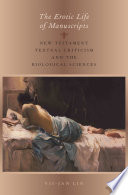New Testament textual critics who used language to group texts into families and genealogies were not pioneering new approaches, but rather borrowing the metaphors and methods of natural scientists. Texts began to be classified into “families, tribes, and nations,” and later were racialized as “African” or “Asian,” with distinguishable “textual physiognomies” and “textual complexions.” These genealogies would later be traced to show the inheritance of “corruptions” and “contamination” through generations, an understanding of textual diversity reflective of eighteenth- and ninteenth-century European anxieties over racial corruption and degeneration. While these biological metaphors have been powerful tools for textual critics, they also produce problematic understandings of textual “purity” and agency, with the use of scientific discourse artificially separating the work of textual criticism from literary interpretation.

